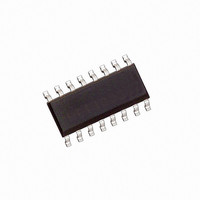HCPL-316J Avago Technologies US Inc., HCPL-316J Datasheet - Page 31

HCPL-316J
Manufacturer Part Number
HCPL-316J
Description
OPTOCOUPLER GATE DRV 2A 16-SOIC
Manufacturer
Avago Technologies US Inc.
Datasheet
1.HCPL-316J-500E.pdf
(33 pages)
Specifications of HCPL-316J
Configuration
High-Side
Input Type
Differential
Delay Time
300ns
Current - Peak
2.5A
Number Of Configurations
1
Number Of Outputs
1
Voltage - Supply
4.5 V ~ 5.5 V
Operating Temperature
-40°C ~ 100°C
Mounting Type
Surface Mount
Package / Case
16-SOIC (0.300", 7.5mm Width)
No. Of Channels
1
Isolation Voltage
3.75kV
Optocoupler Output Type
Gate Drive
Input Current
22mA
Output Voltage
30V
Opto Case Style
SOIC
No. Of Pins
16
Propagation Delay Low-high
0.5µs
Lead Free Status / RoHS Status
Contains lead / RoHS non-compliant
High Side Voltage - Max (bootstrap)
-
Lead Free Status / RoHS Status
Contains lead / RoHS non-compliant, Contains lead / RoHS non-compliant
Other names
516-1130-5
Available stocks
Company
Part Number
Manufacturer
Quantity
Price
Company:
Part Number:
HCPL-316J
Manufacturer:
AVAGO
Quantity:
20 700
Company:
Part Number:
HCPL-316J
Manufacturer:
AD
Quantity:
1 939
Part Number:
HCPL-316J
Manufacturer:
AGILENT
Quantity:
20 000
Company:
Part Number:
HCPL-316J#500
Manufacturer:
AGILENT
Quantity:
3 169
Part Number:
HCPL-316J#500
Manufacturer:
AGILENT
Quantity:
20 000
Company:
Part Number:
HCPL-316J-000E
Manufacturer:
KOITECH
Quantity:
713
Company:
Part Number:
HCPL-316J-000E
Manufacturer:
AVAGO
Quantity:
21 000
Part Number:
HCPL-316J-000E
Manufacturer:
AVAGO/安华高
Quantity:
20 000
Part Number:
HCPL-316J-500E
Manufacturer:
AVAGO/安华高
Quantity:
20 000
Part Number:
HCPL-316J-500E/HCPL316J-500E
Manufacturer:
AVAGO/安华高
Quantity:
20 000
Thermal Model
The HCPL-316J is designed to dissipate the majority of
the heat through pins 4 for the input IC and pins 9 and 10
for the output IC. (There are two V
side, pins 9 and 10, for this purpose.) Heat flow through
other pins or through the package directly into ambient
are considered negligible and not modeled here.
In order to achieve the power dissipation specified in
the absolute maximum specification, it is imperative
that pins 4, 9, and 10 have ground planes connected to
them. As long as the maximum power specification is
not exceeded, the only other limita tion to the amount
of power one can dissipate is the absolute maximum
junction temperature specification of 125°C. The junc-
tion temperatures can be calculated with the following
equations:
T
T
where P
put IC. Since T
and airflow, their exact number may not be available.
Therefore, a more accurate method of calcu lat ing the
junction temperature is with the following equations:
T
T
These equations, however, require that the pin 4 and pins
9, 10 temperatures be measured with a thermal couple
on the pin at the HCPL-316J package edge.
Figure 78. HCPL-316J thermal model.
31
ji
jo
ji
jo
θ
θ
= P
= P
= P
= P
4A
i4
= 60°C/W
= 50°C/W*
i
i
T
o
o
(T
T
i4
(T
i
i4
o9,10
= power into input IC and P
+ T
o9,10
+ T
T
P4
T
P4
+ T
4A
ji
4A
+ T
) + T
P9,10
and T
9,10A
T
A
A
) + T
T
9,10A
P9,10
T
jo
θ
A
9,10A
θ
are dependent on PCB layout
O9,10
= 50°C/W*
= 30°C/W
EE
o
pins on the output
= power into out-
T
T
T
T
T
T
T
T
*The T
in Figure 78 with reasonable air flow. This value may increase or
decrease by a factor of 2 depending on PCB layout and/or airflow.
ji
jo
P4
P9,10
I4
I9,10
4A
9,10A
= junction temperature of input side IC
= junction temperature of output side IC
= input side IC to pin 4 thermal resistance
= pin 4 temperature at package edge
= pin 4 to ambient thermal resistance
= output side IC to pin 9 and 10 thermal resistance
= pin 9 and 10 temperature at package edge
= pin 9 and 10 to ambient thermal resistance
4A
and T
9,10A
From the earlier power dissipation calculation example:
P
the thermal model shown in Figure 77 below.
T
T
both of which are within the absolute maximum specifi-
cation of 125°C.
If we, however, assume a worst case PCB layout and no
air flow where the estimated q
Then the junction temperatures become
T
T
The output IC junction temperature exceeds the abso-
lute maximum specification of 125°C. In this case, PCB
layout and airflow will need to be designed so that the
junction temperature of the output IC does not exceed
125°C.
If the calculated junction temperatures for the thermal
model in Figure 78 is higher than 125°C, the pin temper-
ature for pins 9 and 10 should be measured (at the pack-
age edge) under worst case operating environment for a
more accurate estimate of the junction temperatures.
i
ji
jo
ji
jo
values shown here are for PCB layouts shown
= 90.8 mW, P
= (90.8 mW)(60°C/W + 50°C/W) + 100°C
= (217.3 mW)(30°C/W + 50°C/W) + 100°C
= 117°C
= (90.8 mW)(60°C/W + 100°C/W) + 100°C
= 115°C
= (217.3 mW)(30°C/W + 100°C/W) + 100°C
= 128°C
= 110°C
o
= 217.3 mW, T
A
4A
= 100°C, and assuming
and q
9,10A
are 100°C/W.











